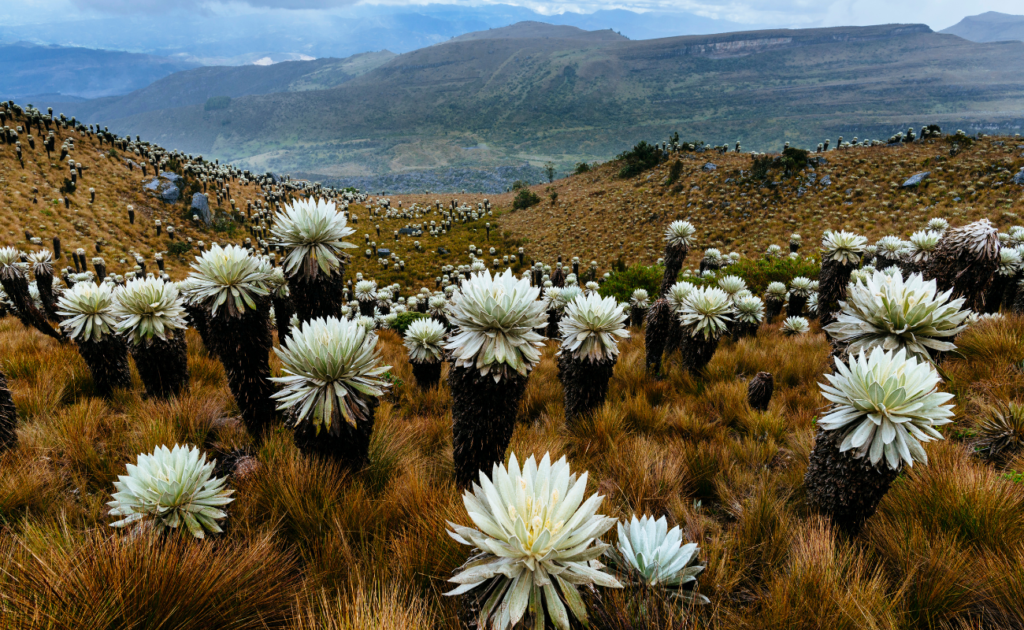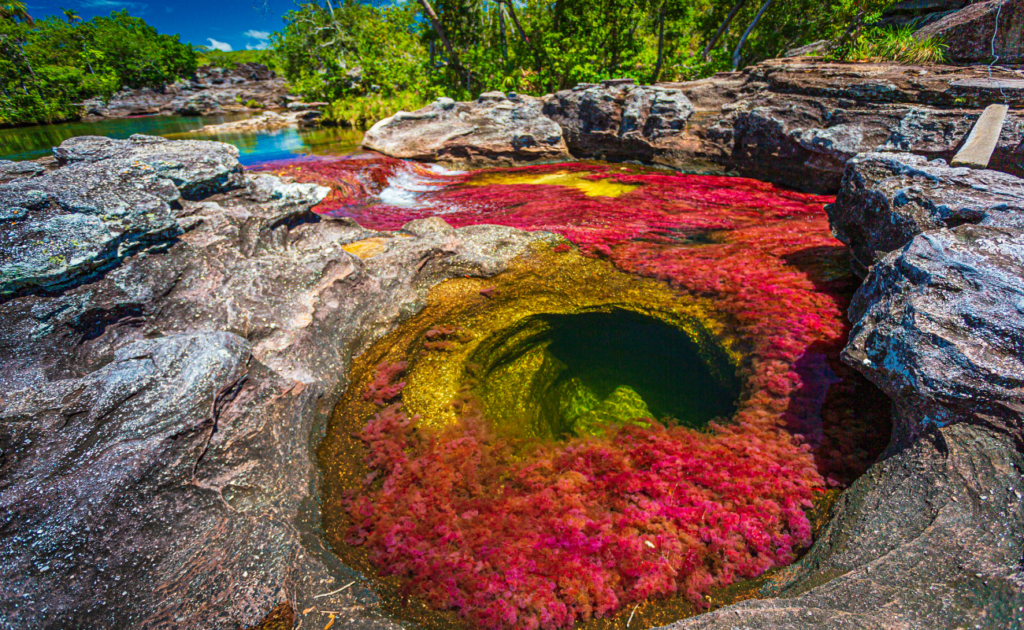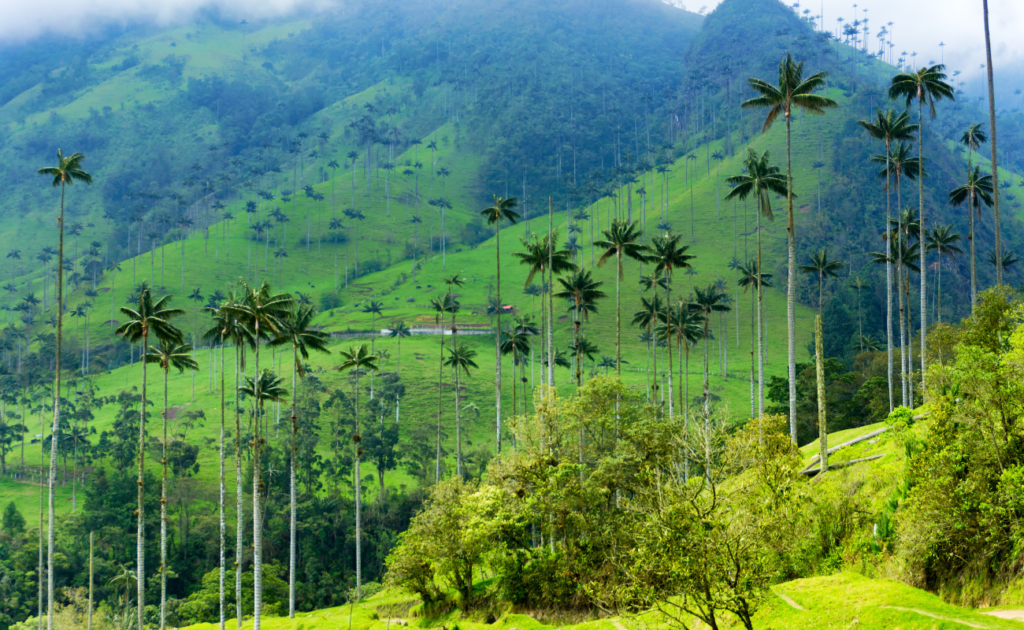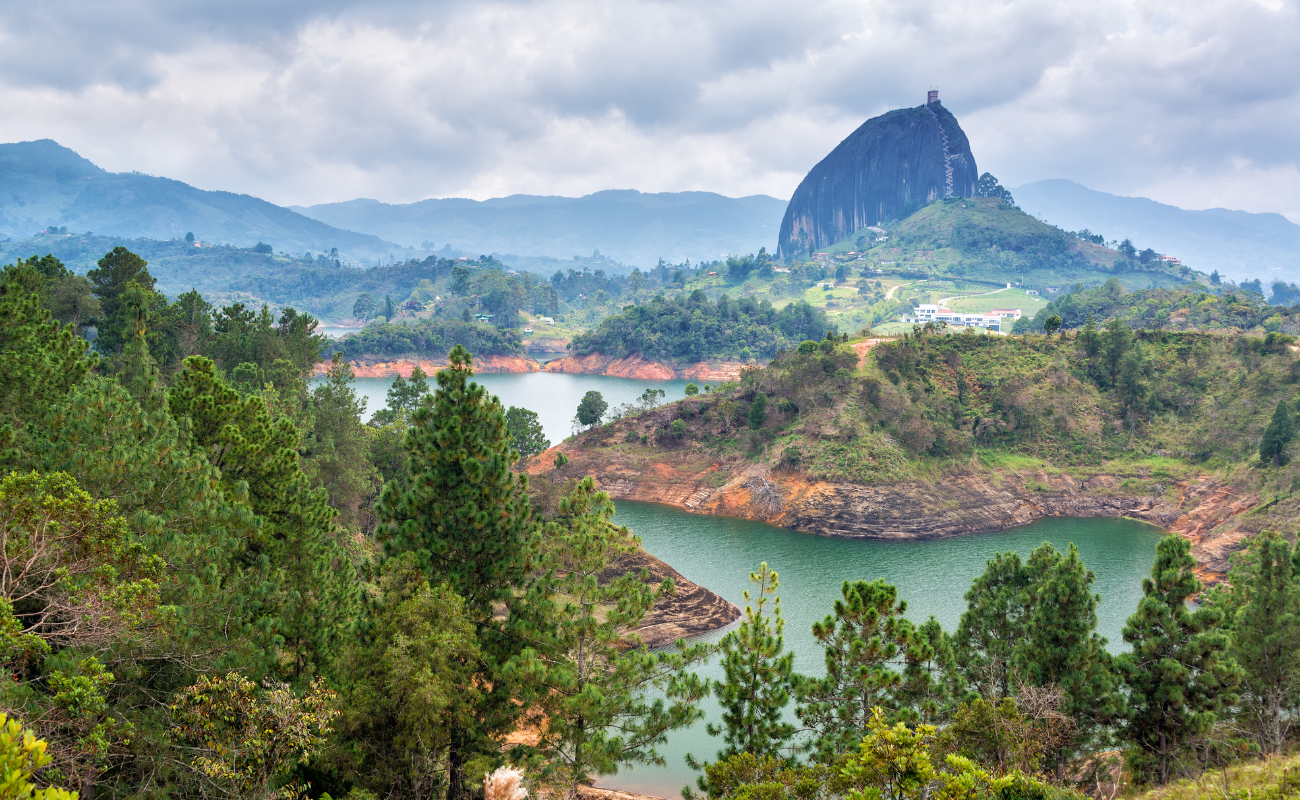Colombia isn’t just beautiful; it’s officially recognized as the most biodiverse country per square kilometer globally. Colombia’s incredible variety of ecosystems is home to an astonishing array of plant and animal species, from the lush Amazon rainforest to the towering Andes and vibrant Caribbean coast. But Colombia’s biodiversity offers more than just breathtaking landscapes and wildlife; it also creates many business opportunities.
In this blog, we’ll explore how Colombia’s status as the most biodiverse country opens doors for innovative and sustainable businesses. Whether you’re thinking about relocating, starting a new venture, or simply curious about the potential within Colombia’s borders, you’ll discover why this country is a must-visit destination and an ideal place to invest and grow.
Why is Colombia the most biodiverse country?
Colombia is often celebrated as the most biodiverse country per square kilometer in the world, and several unique geographical factors contribute to this remarkable status.
Strategic location
Colombia’s location at the crossroads of Central and South America plays a significant role in its biodiversity. This strategic position allows the country to be influenced by various climates and ecosystems, ranging from tropical rainforests to mountainous regions and coastal areas. The country is home to the Pacific and Atlantic Oceans and the vast Amazon rainforest, which all contribute to the wide range of habitats supporting an extraordinary diversity of life.
Varied topography
The country’s topography is incredibly diverse, with the Andes mountain range splitting into three branches as it runs through the country. These mountain ranges create distinct climate zones, from the snow-capped peaks to the lush valleys below. This variation in altitude results in different ecosystems stacked on top of one another, each supporting unique species of plants and animals. Colombia’s varied landscapes foster unparalleled biodiversity, from páramos and cloud forests to savannas and wetlands.
Multiple climate zones
Colombia’s variety of climate zones, from tropical rainforests to temperate highlands, means the country can support an incredible range of species. Each climate zone is home to its unique flora and fauna, which adds to the country’s overall biodiversity. The Amazon rainforest, for example, is one of the most species-rich areas on the planet, while the coastal mangroves and coral reefs contribute to the country’s marine biodiversity.
Biological corridors
It´s location also provides a natural bridge for species migration between North and South America. This has allowed for the mixing of species from different regions, further enhancing its biodiversity. The country’s numerous rivers and mountain ranges act as biological corridors that enable species to move and adapt, creating a dynamic environment where biodiversity can thrive.
Endemic species
Colombia’s diverse ecosystems are home to many endemic species—plants and animals found nowhere else on Earth. The isolation of certain habitats, such as the unique conditions found in the Andes or the Amazon, has led to species uniquely adapted to these environments. This high level of endemism is another reason why Colombia is considered the most biodiverse country.
The global importance of Colombia’s biodiversity
As the most biodiverse country per square kilometer, Colombia plays a crucial role on the global stage. The incredible variety of species and ecosystems within its borders profoundly impacts the world, particularly regarding conservation and environmental sustainability.
Colombia’s vast biodiversity is a vital resource for the planet. The country is home to thousands of species of plants, animals, and microorganisms, many of which are not found anywhere else on Earth. This rich biodiversity provides essential ecological services, such as carbon sequestration, water purification, and soil fertility, which are critical to the health of our planet. By preserving Colombia’s ecosystems, we help maintain the life balance on Earth.
The country it is also recognized as one of the world’s most important conservation hotspots. With its diverse range of habitats, the country is a priority for global conservation efforts. Protecting Colombia’s ecosystems is essential for preserving the planet’s overall biodiversity, as the loss of species in such a rich environment could have far-reaching consequences.
International organizations and governments increasingly focus on Colombia as a key player in global conservation strategies, emphasizing the need to protect its natural resources for future generations.
In addition, Colombia’s biodiversity can potentially drive significant advancements in medicine and agriculture. Many of the world’s medicines are derived from plant and animal species in biodiverse regions like Colombia. The country’s natural resources offer endless opportunities to discover new pharmaceuticals and treatments. Additionally, Colombia’s biodiversity is vital for agricultural research, as it provides a genetic pool that can help develop more resilient and productive crops, contributing to global food security.
Not less important, Colombia’s vast forests, particularly in the Amazon region, play a critical role in regulating the Earth’s climate. These forests act as carbon sinks, absorbing large amounts of CO2 from the atmosphere and helping mitigate climate change’s effects. Protecting these ecosystems is essential for maintaining global climate stability. The conservation of Colombia’s forests and other natural habitats is necessary for the country and the world, as these ecosystems are vital in the global fight against climate change.
Colombia’s approach to conserving its biodiversity while promoting sustainable development is a model for other countries. By balancing economic growth with environmental protection, Colombia demonstrates how biodiversity can be leveraged to create sustainable business opportunities, improve livelihoods, and promote long-term ecological stewardship. This model is increasingly being recognized and adopted by other nations looking to protect their natural resources while fostering economic development.

Colombia’s Biodiversity
Rich ecosystems and landscapes
Colombia’s landscapes are a testament to nature’s incredible diversity, from the dense rainforests of the Amazon to the towering peaks of the Andes and from the pristine coastal areas to the vast savannas.
Amazon Rainforest
The Amazon rainforest is one of Colombia’s most iconic ecosystems. This dense, tropical forest covers a significant portion of the country’s southeast and is home to an incredible array of plant and animal species. The Amazon is a biodiversity hotspot, with countless species of trees, birds, insects, and mammals, many of which are found nowhere else on Earth. This lush ecosystem plays a vital role in global climate regulation and is a key area for conservation efforts.
The Andes mountains
The Andes mountain range, which runs through the western part of Colombia, is another critical ecosystem that contributes to the country’s status as the most biodiverse country. The Andes create a variety of microclimates and habitats, ranging from cool, high-altitude páramos to lush cloud forests. These diverse environments support an incredible range of flora and fauna, including unique species like the Andean condor and the spectacled bear. The Andes are also home to many endemic plants adapted to the mountainous terrain.
Coastal areas and mangroves
Colombia’s coastal regions, flanked by the Pacific Ocean and the Caribbean Sea, add to the country’s ecological richness. The coastal ecosystems include mangrove forests, coral reefs, and sandy beaches, each supporting different forms of life. Mangroves, for example, are vital nurseries for fish and other marine life, while coral reefs are teeming with colorful fish, sea turtles, and other aquatic species. These coastal areas are essential for biodiversity and the livelihoods of local communities who depend on fishing and tourism.
The Orinoco and savannas
The Orinoco region lies in the eastern part of Colombia, characterized by vast savannas and wetlands. This unique ecosystem supports large populations of wildlife, including capybaras, anacondas, and jaguars. The Orinoco’s wetlands are crucial for water regulation and provide habitats for many migratory birds. The savannas also support traditional cattle ranching, which coexists with the region’s rich biodiversity.
The Chocó rainforest
The Chocó region, located along Colombia’s Pacific coast, is a biodiversity jewel and one of the wettest places on Earth. This rainforest is characterized by its high rainfall levels, dense vegetation, and unique species, many of which are found only in this part of the world. The Chocó’s isolation has allowed many species to evolve independently, contributing to its status as a center of endemism.
Diverse flora and fauna
The country’s vast range of ecosystems supports an astonishing variety of plant and animal species, many of which are found nowhere else on Earth. This incredible biodiversity makes Colombia a top destination for those who appreciate the wonders of nature.
Colombia’s diverse climates and landscapes create ideal conditions for an incredible array of plant life. The country is home to over 28,000 species of plants, with thousands of them being endemic—meaning they are found only in Colombia. The Amazon rainforest hosts an unimaginable variety of trees, orchids, and medicinal plants. In the Andes, unique páramo vegetation, such as frailejones, plants adapted to the cold, high-altitude environment. Colombia is also renowned for its stunning array of orchids, with over 4,000 species, making it one of the top orchid-rich countries in the world.
On the other hand, the country is home to an extraordinary number of bird species—nearly 2,000—making it a birdwatcher’s dream. Colombia’s avian diversity is unmatched, from the vibrant Andean condor soaring over the mountains to the elusive Harpy eagle in the Amazon. The country also hosts various mammals, including jaguars, sloths, and the spectacled bear, the only bear species native to South America.
In addition to mammals and birds, Colombia’s waters are teeming with life. The country’s rivers, lakes, and coastal areas are home to pink river dolphins, manatees, and countless fish species. The coral reefs along the Caribbean coast are vibrant with marine life, including colorful fish, sea turtles, and rays.
One of the most remarkable aspects of Colombia’s biodiversity is the high number of endemic species—those that are found nowhere else on Earth. This includes plants, animals, amphibians, reptiles, and insects. For example, the poison dart frog, known for its bright colors and toxic skin, is native to Colombia’s rainforests. Similarly, the golden poison frog, one of the most poisonous animals in the world, can only be found in Colombia’s Chocó region.
For nature enthusiasts, Colombia is an unparalleled destination. Whether you’re exploring the Amazon rainforest, hiking through the Andes, or diving in the coral reefs of the Caribbean, you’ll encounter a rich tapestry of life that’s hard to find anywhere else. The country’s diverse flora and fauna offer endless opportunities for discovery and appreciation, making it a must-visit location for anyone who loves nature.

Colombia as a destination for eco-tourism
Top Eco-Tourism Destinations
As the most biodiverse country, Colombia offers an unparalleled experience for eco-tourists. With its rich ecosystems and stunning natural landscapes, the country is a top destination for those looking to immerse themselves in nature and explore some of the world’s most pristine environments. Here are some of the vital eco-tourism spots in Colombia that should be on every nature lover’s list.
The Amazon rainforest
This dense, tropical forest is a haven for biodiversity, covering a vast area of southeastern Colombia. Visitors to the Amazon can experience the incredible variety of plant and animal life that calls this region home, including jaguars, pink river dolphins, and countless bird species. Eco-tourists can explore the rainforest through guided treks, boat tours along the Amazon River, and stays in eco-lodges that offer an immersive experience in one of the world’s most vital ecosystems. The Amazon is a true testament to why Colombia is the most biodiverse country.
Sierra Nevada de Santa Marta
The Sierra Nevada de Santa Marta is another must-visit destination for eco-tourists in Colombia. This coastal mountain range is the highest in the world and is home to various ecosystems, from tropical rainforests at the base to snow-capped peaks at the summit.
The region is also home to several indigenous communities that have lived harmoniously with nature for centuries. Visitors can explore the Lost City (Ciudad Perdida), an ancient archaeological site, or trek through the diverse landscapes, encountering unique flora and fauna. The Sierra Nevada combines biodiversity and culture, offering a unique eco-tourism experience.
Tayrona National Park
Located on Colombia’s Caribbean coast, Tayrona National Park is one of the country’s most popular eco-tourism spots. This stunning park offers a mix of lush rainforests, beautiful beaches, and rich biodiversity. Visitors can hike through the forested trails, where they may spot howler monkeys, exotic birds, and various plant species.
The park’s beaches, with their crystal-clear waters and coral reefs, are perfect for snorkeling and diving, offering a glimpse into Colombia’s marine biodiversity. Tayrona National Park is a perfect example of Colombia’s natural beauty and biodiversity, which make it an ideal destination for eco-tourism.
Chingaza National Park
For those looking to explore Colombia’s Andean ecosystems, Chingaza National Park is a top choice. Located near Bogotá, this park is known for its páramo landscapes—a unique high-altitude ecosystem found only in a few places worldwide.
The park is home to various wildlife, including the spectacled bear, deer, and over 180 species of birds. The park’s numerous lakes and rivers are also significant regional water sources. Visitors can enjoy hiking, birdwatching, and learning about the ecological significance of the páramo, all while taking in breathtaking views of the Andean mountains.
Caño Cristales
Often referred to as the “River of Five Colors,” Caño Cristales is one of Colombia’s most unique natural wonders. Located in the Serranía de la Macarena region, this river is famous for its vibrant colors caused by aquatic plants that bloom in the riverbed.
The river’s striking hues, combined with the surrounding landscapes of savannas and tropical forests, make it a one-of-a-kind destination for eco-tourists. The area is also rich in biodiversity, with various plant and animal species to discover.

Business opportunities in Colombia’s biodiversity
Having the privilege of being one of the most biodiverse countries, Colombia offers many business opportunities rooted in its rich natural resources. The country’s incredible biodiversity is not just a treasure to be protected; it’s also a source of sustainable economic growth. Two of the most promising sectors are sustainable agriculture and bioprospecting, attracting entrepreneurs and investors eager to tap into Colombia’s natural wealth.
Colombia’s diverse climates and fertile soils create ideal conditions for organic farming, which is increasingly in demand locally and internationally. From coffee and cacao to exotic fruits and medicinal plants, organic farming in Colombia offers a way to produce high-quality, sustainable products that appeal to health-conscious consumers worldwide.
Organic farming practices in Colombia protect the environment and preserve local biodiversity. By using natural methods to cultivate crops, farmers can maintain soil fertility and prevent deforestation, which is crucial in a country as ecologically rich as Colombia. This approach meets global demand for organic products and contributes to Colombia’s unique ecosystems conservation.
Bioprospecting—the search for plant and animal species that can be used for medicinal, agricultural, or industrial purposes—is another lucrative opportunity in Colombia. The country’s vast range of ecosystems harbors countless species that have yet to be thoroughly studied or utilized. Colombia’s biodiversity offers immense potential for discovery and innovation, from plants with potential medicinal properties to unique microorganisms that can be used in biotechnology.
Colombia presents a goldmine of possibilities for businesses involved in bioprospecting. Collaborations with local communities, researchers, and conservation organizations can lead to the development of new pharmaceuticals, natural cosmetics, and other products derived from the country’s rich biodiversity. These ventures have the potential for significant financial returns and contribute to the sustainable use and conservation of Colombia’s natural resources.
In addition to agriculture and bioprospecting, reforestation projects in Colombia offer another compelling business opportunity, mainly through initiatives like Colombian Carbon Credits. As the world increasingly focuses on combating climate change, reforestation projects are gaining attention as both an environmental necessity and a profitable investment.
Colombia’s reforestation projects focus on planting native tree species, restoring degraded lands, and capturing atmospheric carbon dioxide. By investing in these projects, businesses can earn carbon credits, which can be sold to companies looking to offset their carbon emissions. This provides a financial return and is vital in mitigating climate change and preserving Colombia’s biodiversity.
The Colombian Carbon Credits project, for example, is an initiative that combines reforestation with sustainable development. Investors in this project contribute to the restoration of Colombia’s forests while generating income through the sale of carbon credits. These efforts help protect the country’s ecosystems, support local communities, and create a sustainable business model that benefits both the environment and the economy.
Relocating to Colombia for business
Colombia is not only known as the most biodiverse country but is also emerging as a prime destination for entrepreneurs and investors. The country’s growing economy, favorable business environment, and supportive government policies make it an attractive place to start and grow a business.
Starting a business in Colombia requires compliance with local laws and regulations. This includes registering your business with the Colombian Chamber of Commerce, obtaining a tax identification number (NIT), and securing your industry’s necessary permits and licenses. Understanding labor laws, including employment contracts, benefits, and social security contributions, is essential. Partnering with a local legal expert or business consultant can help you navigate these requirements smoothly.
The country has a stable banking system, and opening a business account is relatively straightforward. However, it’s essential to be aware of currency exchange rates, taxation, and accounting practices. Colombia has a value-added tax (VAT) system, and corporate income tax rates vary depending on the size and type of business. Engaging a local accountant or financial advisor can help you manage your finances effectively and ensure compliance with Colombian tax laws.
For foreign entrepreneurs, obtaining the correct visa is crucial in relocating to Colombia. The Colombian government offers several visa options for business owners, including the Migrant Visa (M) for entrepreneurs who invest in local businesses and the Resident Visa (R) for those who have maintained long-term investments in the country. Ensuring you have the correct visa and residency status is important for your business operations and personal peace of mind.

How Gutierrez Group Can Help
Relocating to Colombia, the most biodiverse country, and starting a business can be an exciting but complex. That’s where the Gutierrez Group comes in. We specialize in helping entrepreneurs and investors navigate the challenges of moving to and establishing a business in Colombia, offering expert guidance every step of the way.
Moving to a new country involves many details, from finding the right living place to understanding local customs and regulations. Gutierrez Group provides comprehensive relocation services to make your transition as smooth as possible. We assist with everything from securing housing and setting up utilities to helping you understand the local culture and business environment. Our team ensures you feel at home in Colombia and are well-prepared to start your new venture.
Our commitment to your success doesn’t end once your business runs. Gutierrez Group provides ongoing support to help you adapt and grow in Colombia’s dynamic market. We offer continuous advice on expanding your business, optimizing operations, and staying compliant with evolving regulations. Our team is always available to assist with any challenges or opportunities, ensuring you have the support you need to thrive in Colombia.
Conclusion
Colombia, the most biodiverse country in the world, offers more than just breathtaking natural beauty; it’s a thriving hub for business opportunities. From sustainable agriculture and bioprospecting to reforestation projects like Colombian Carbon Credits, the country’s rich biodiversity presents countless possibilities for innovative and profitable ventures. Whether relocating to start a new business or investing in Colombia’s natural wealth, the Gutierrez Group guides you every step, ensuring a successful transition and long-term growth in this dynamic market.


